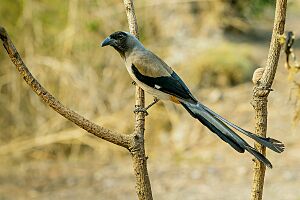Grey treepie facts for kids
Quick facts for kids Grey treepie |
|
|---|---|
 |
|
| Subspecies formosae from Taiwan | |
| Conservation status | |
| Scientific classification | |
| Genus: |
Dendrocitta
|
| Species: |
formosae
|
| Subspecies | |
|
|
| Synonyms | |
|
|
The grey treepie (Dendrocitta formosae), also called the Himalayan treepie, is a cool bird from Asia. It's a medium-sized bird with a long tail. It belongs to the crow family, just like jays and magpies!
This bird was first officially described by a scientist named Robert Swinhoe in 1863. Grey treepies live in many places. You can find them along the base of the Himalayas in places like India and also in Southeast Asia, southern China, and Taiwan. There are different types of grey treepies, and they look a bit different depending on where they live.
Grey treepies eat many kinds of food, so they are called omnivorous. They usually hang out in thick forests and among lots of leaves. Sometimes, they even team up with other birds, like laughingthrushes, to find food. They often search for food together in hill forests, especially in the mornings. They like to explore rhododendrons, oaks, and other trees with wide leaves.
Contents
What Does the Grey Treepie Look Like?
The grey treepie is about 36 to 40 centimeters (14 to 16 inches) long. It weighs between 89 and 121 grams (about 3 to 4 ounces). This bird is similar in size to other Dendrocitta species. You can tell it apart because its body is mostly grey.
Birds living in the western parts of its home range have a greyish bottom (rump) and some grey on their tail. But those in the eastern areas have a white rump and a black tail. The treepie's face and throat are dark, almost like it's wearing a black mask. Its belly is grey, turning whiter near its bottom. The back and shoulders are brownish. The top of its head and neck are greyish. Its black wings have a clear white patch. The area near its tail is reddish-brown. The outer tail feathers and the tips of the middle ones are black.
The treepie has a black beak, dark brownish-black legs, and red or reddish-brown eyes. Male and female grey treepies look very similar. Young birds are a bit duller in color. They have a browner neck, and all their feathers have reddish-brown tips.
Since these birds live in such a large area, there are several types, called subspecies. They have small differences in color or tail length. For example, the occidentalis type from the western Himalayas has a slightly longer tail. The himalayana type lives from the central Himalayas to Thailand and Vietnam. There's also a type called sarkari in India that might have a smaller beak. Other types include assimilis, sapiens, sinica, formosae (the original type from Taiwan), and insulae from Hainan Island.
Where Do Grey Treepies Live?
Grey treepies spend most of their time in trees. They live in many different places, including forests, farmlands, and even near human homes. You can find them in the foothills of the Himalayas, in parts of India, Bangladesh, Myanmar, Thailand, China, Hainan, Taiwan, and northern Indochina.
In the Himalayas, they can live as high as 2,400 meters (about 7,900 feet) above sea level. In southeastern China, they are found between 400 meters (about 1,300 feet) and 1,200 meters (about 3,900 feet) high.
Behaviour and Life Cycle
These treepies mostly find their food in trees. However, they will sometimes look for food on the ground, especially in areas where people grow crops. They eat a wide variety of things! This includes many kinds of insects and other small creatures, berries, flower nectar, grains, and seeds. They also eat small reptiles, eggs, and baby birds. As mentioned before, they sometimes join groups of different bird species to search for food together.
In the Himalayan foothills of India, grey treepies usually build their nests from May to July. They build a shallow, cup-shaped nest lined with hair. These nests are found in trees, bushes, or clumps of bamboo. A female treepie usually lays 3 to 4 eggs. The eggs can be whitish, buff (pale yellowish-brown), or pale green, with brown or grey spots. Both the male and female treepie work together to build the nest and feed their young birds.
The grey treepie has a loud, harsh voice. It makes a grating k-r-r-r-r sound. But it also has more musical calls, some sounding like tiddly-aye-kok or ko-ku-la. They can even make barking sounds like braap...braap...braap.
Are Grey Treepies Endangered?
We don't know the exact number of grey treepies in the world. In China, there are likely between 10,000 and 100,000 breeding pairs. Taiwan also has an estimated 10,000 to 100,000 breeding pairs. The population on Hainan Island might be in danger because their homes are being destroyed.
However, the grey treepie lives in a very large area. The number of these birds does not seem to be dropping very quickly. Because of this, the IUCN Red List says that the species is of least concern. This means they are not currently considered to be at high risk of extinction.




